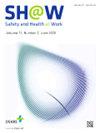蒙古手工金矿开采:二氧化硅暴露和矽肺病风险因素-实地调查
IF 2.9
3区 医学
Q1 PUBLIC, ENVIRONMENTAL & OCCUPATIONAL HEALTH
引用次数: 0
摘要
矽肺病仍然是一个重要的职业健康挑战,特别是在手工和小规模金矿工人中。本研究调查了蒙古手工矿工矽肺病的患病率及其相关危险因素,同时评估了蒙古手工矿工的可吸入粉尘和结晶二氧化硅暴露水平。方法采用横断面调查方法,对蒙古巴彦淖尔省察坎察希尔族手工采金工人124名进行调查。参与者完成了问卷调查,并接受了包括肺活量测定和x光检查在内的医学检查。每个工作日采集粉尘样本(n = 10),工作场所分为地下勘探区和室外磨矿区。多因素分析评估矽肺的危险因素。结果地下采石(干采)暴露量最高,粉尘几何平均(GM)为8.107 mg/m3;二氧化硅GM: 2.156 mg/m3),其次是研磨(粉尘GM: 1.374 mg/m3;二氧化硅GM: 0.555 mg/m3)。湿采石和包装任务的水平明显较低。共纳入124名男性参与者(平均年龄35.9岁,平均工作年限5.7年)。24名参与者(19.4%)患有矽肺,其中58%患有重度2级或以上。多变量分析显示,工作年限较长(OR = 2.6)和特定工作岗位(如地下钻探:OR = 6.23)增加矽肺病的发病率。结论蒙古手工采金工人因高硅暴露和防护措施不足,面临重大健康风险。需要采取紧急干预措施,包括改进粉尘控制和常规医疗监测,以减轻这一脆弱人群的矽肺病风险。本文章由计算机程序翻译,如有差异,请以英文原文为准。
Artisanal Gold Mining in Mongolia: Silica Exposure and Silicosis Risk Factors-Field Survey
Background
Silicosis remains a critical occupational health challenge, particularly among artisanal and small-scale gold miners (ASGM). This study investigates the prevalence of silicosis and its associated risk factors, while assessing the levels of respirable dust and crystalline silica exposure in Mongolian artisanal miners.
Methods
A cross-sectional survey was conducted with 124 employees of the Tsagaan Tsakhir artisanal gold miners in Bayankhongor Province, Mongolia. Participants completed questionnaires and underwent medical exams, including spirometry and X-rays. Dust samples (n = 10) were collected during a working day, and the workplace was divided into underground exploration and outdoor grinding areas. Multivariate analysis evaluated risk factors for silicosis.
Results
Underground quarrying (dry) showed the highest exposures (dust geometric mean (GM): 8.107 mg/m3; silica GM: 2.156 mg/m3), followed by grinding (dust GM: 1.374 mg/m3; silica GM: 0.555 mg/m3). Wet quarrying and packaging tasks had significantly lower levels. A total of 124 male participants (mean age 35.9, mean work years 5.7) were included. Twenty four participants (19.4%) had silicosis, with 58% having profusion 2 or higher. Multivariate analysis showed increased odds of silicosis with longer work years (OR = 2.6) and specific work positions (e.g., underground drilling: OR = 6.23).
Conclusion
Artisanal gold miners in Mongolia face significant health risks due to high silica exposure and inadequate protective measures. Urgent interventions, including improved dust control and routine medical surveillance, are needed to mitigate silicosis risks in this vulnerable population.
求助全文
通过发布文献求助,成功后即可免费获取论文全文。
去求助
来源期刊

Safety and Health at Work
Social Sciences-Safety Research
CiteScore
6.40
自引率
5.70%
发文量
1080
审稿时长
38 days
期刊介绍:
Safety and Health at Work (SH@W) is an international, peer-reviewed, interdisciplinary journal published quarterly in English beginning in 2010. The journal is aimed at providing grounds for the exchange of ideas and data developed through research experience in the broad field of occupational health and safety. Articles may deal with scientific research to improve workers'' health and safety by eliminating occupational accidents and diseases, pursuing a better working life, and creating a safe and comfortable working environment. The journal focuses primarily on original articles across the whole scope of occupational health and safety, but also welcomes up-to-date review papers and short communications and commentaries on urgent issues and case studies on unique epidemiological survey, methods of accident investigation, and analysis. High priority will be given to articles on occupational epidemiology, medicine, hygiene, toxicology, nursing and health services, work safety, ergonomics, work organization, engineering of safety (mechanical, electrical, chemical, and construction), safety management and policy, and studies related to economic evaluation and its social policy and organizational aspects. Its abbreviated title is Saf Health Work.
 求助内容:
求助内容: 应助结果提醒方式:
应助结果提醒方式:


